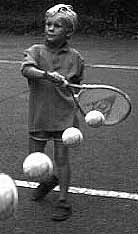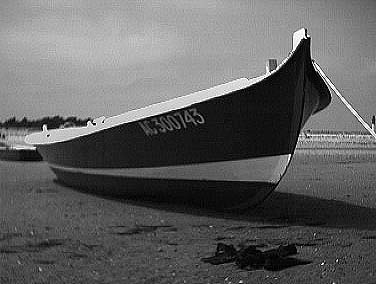
The claimed depth of field is from 1 metre to infinity. Sharpness is reasonable at the closer extreme.
Logitech's FotoMan is an electronic camera
with a difference. Unlike Canon's Ion, which uses removable floppy disks
to record analogue video stills in colour, FotoMan digitises its monochrome
images inside the camera. While the Ion's video images have to be digitised
using another piece of quite costly hardware, FotoMan's are ready to be
imported direct from the camera into a personal computer running Microsoft
Windows 3.0 or 3.1. The only additional hardware needed is a special cable,
supplied with the camera, to connect FotoMan to the serial port of the computer.
This is the way of the future and the FotoMan camera is so revolutionary,
so futuristic, that it is undoubtedly the product of the imagination of
some visionary of the future of photography.
In the earlier part of the century, optical sophistication joined forces
with mechanical genius to bring precision optical and mechanical instruments
such as the Leica and Contax cameras to our fathers and grandfathers. These
cameras are as much a joy to have and to hold today as when they revolutionised
the photographic world all those years ago. Most still function as sweetly
as the day they were individually, and lovingly, created. The tradition
continues today, through cameras such as the Hasselblad 205TCC and Nikon
F4. But there is a difference: these cameras add to the finest optics and
mechanics the very latest in electronic sophistication.
It is not many years since cameras employing electronics were viewed with
considerable suspicion. When Nikon introduced the F3 in the late 1970s,
the secondhand price of the obsolescent F2 shot up. The F2 was mechanical,
and many professionals were sceptical about the reliability of the new battery-dependent
F3. But, in time, the F3 earned its reputation as a reliable workhorse and
suspicion gave way to trust. Despite its electronics, the F3, like the later
F4, was mainly a mechanical device with an iris diaphragm, mirror, shutter
and film transport. Even the latest Nikon, the F90, is mainly mechanical.

FotoMan is an important landmark in still
camera design because it removes the hitherto important area of mechanics
almost entirely. This makes it the first totally digital camera.
The camera has one moving part: the shutter release button and even this
easily could be replaced with a solid state device. The FotoMan's shutter
release button is the last mechanical link with cameras as we have known
them. Pushing the button is accompanied by the reassuringly familiar sound
of a shutter operating but this is a simulated sound, generated to serve
no purpose other than to reassure the photographer that an exposure has
been made. The sound is followed, after about eleven seconds, by a second
sound indicating that the exposure has been "saved" in the camera's
internal solid state memory. Without these sounds, or with the facility
to turn them off as required, the camera would be completely silent. Imagine
how useful that would be, for example, on the set of a movie being shot
with sync sound. Today, the taking of still photographs has to stop whenever
the First Assistant calls "action": no single lens reflex camera
is quiet enough.
Logitech's camera is not photography as we know it. The FotoMan and its
associated software, FotoTouch, are revolutionary in ways which will undoubtedly
become highly significant as digital electronic photography matures.
At first I regarded the associated software, FotoTouch, as being rather
crude and basic. Most software for the PC lacks the on-screen visual finesse
of similar software on the Macintosh and this was the first imaging software
I had used on my Toshiba personal computer. In power and facilities FotoTouch
is far from basic and even has some facilities which are as good, if not
slightly better, than the competition's. One such facility is "Equalize",
which compensates for an underexposed shot extremely well, bringing maximum
highlights up to white and darkest tones down to black.
Unfortunately the resolution of the camera is low and unlikely to help you
produce any images of useable professional quality. The camera's monochrome
image sensor has only 106,784 pixels (individual basic picture elements)
on a CCD chip in an array of 284 by 376 pixels. The picture aspect ratio
(height compared to width) is thus 1.32:1, which is virtually identical
to that of television. By way of comparison, Kodak's DCS100 digital camera,
used to take my photograph in front of the fish and chip shop and the photographs
of the FotoMan camera, has an array of 1280 by 1024 pixels - a total of
1,310,720 pixels, with an aspect ratio of 1.25:1, the same as 4x5 and 8x10.

So why bother with the FotoMan, you might
ask?
Maybe you are worried about learning the basics of digital imaging, already
have a personal computer (IBM compatible), but can't justify the cost of
a high-end digital camera yet? In this case the FotoMan might just be the
fun way to start you on your learning curve for not too much outlay, especially
if you shop around for a good discount. The suggested price of the complete
kit (FotoMan camera, case, neutral density filter, battery charger, interface
cable, and FotoTouch software) is £499, one of the cheapest ways to
get into digital imaging.
FotoMan is a digital camera which uses no discs, either removable or internal.
It can take up to thirty two monochrome pictures, stored on its internal
memory - four megabytes of DRAM - until the internal battery runs down.
Battery power can hold the images in DRAM for about twenty four hours, so
it's important to keep the battery charged until you download your pictures
into a computer.
Sensitivity is about ISO200, reduced to ISO25 with the neutral density filter,
supplied to prevent overexposure which results in CCD overload in very bright
light. The electronic shutter is stated to have a speed range of 40 milliseconds
with flash (1/25 second), 1 to 32 milliseconds (1/1000 to 1/30 second) without
flash. A built-in flash will illuminate subjects within a range of 1.2 to
3 metres. The camera weighs 284 grams (10 ounces) and has an unusual shape.
The four finger grips on the front are complemented by two thumb grips on
the rear. This design worked very well. Is this the first camera to be designed
for left handed people?
The camera is definitely amateur in its photographic facilities. It has
a fixed focus f4.5 lens of focal length roughly equivalent to a 55mm lens
on a 35mm film camera. Depth of field is claimed to stretch from 1 metre
to infinity but I found all the pictures lacking in resolution, the most
acceptable being mid-length portraits. Small detail is non existent. Possible
uses might include illustrations in magazines selling second-hand cars,
a field presently occupied by the Canon Ion and likely to remain there until
Logitech come up with a camera which can reproduce more detail.
Images are imported into the computer using FotoMan software, usually in
conjunction with the FotoTouch software which is used to edit and print
them. After establishing connection with the camera, the FotoMan software
displays a screen full of small images, reassuringly bounded by sprocket
holes reminiscent of 35mm film! Maybe this would just rub salt in the wounds
of some die-hards? This same screen tells you how much charge there is in
the camera battery, using the clearest indicator I have seen: a line around
an icon of a battery and a clear percentage figure, too. Once you have imported
your images you have the option to delete them from this same window.
The camera records the date and time when each exposure was made, whether
flash was used, and length of exposure - though why you need that information
on a camera as simple and automatic as this beats me. You can also record
details of the artist (author) and provide a caption. All this is stored
in each image file on the computer.
I like the whole approach of Logitech. The manuals for both camera and software
are clear, informative and not daunting. They will be important players
in digital image origination, if they can come up with cameras which give
much more resolution . . . and colour!

If and when you buy the FotoMan, you can
start to make digital images immediately, without any further cost, if you
already have access to a computer. No film or processing costs. This means
you can experiment and erase your embarrassing results without even the
risk of someone finding the discarded film in your wastebasket! But be warned,
you will soon fill up your hard disc with a multitude of 100 kilobyte images
if you are not totally ruthless about what you keep.
You will doubtless experiment with all the facilities of the FotoTouch image
editing software, tentatively at first and then more daringly. Like a boy
with a new toy, you'll soon be calling out to your staff and family to "come
and look at this!" when you have cloned a second face onto one of them,
or given a "baldy" a new head of hair, "borrowed" from
a friend. If you are really happy with a particular shot, try making a print
on plain paper using your standard printer driven by Microsoft Windows.
When you reach this point - and it really is quite simple - you have become
a digital photographer. You will have experienced a tingle in your spine
similar to the one which you felt when your first image appeared in the
developer. There is no stopping you now!